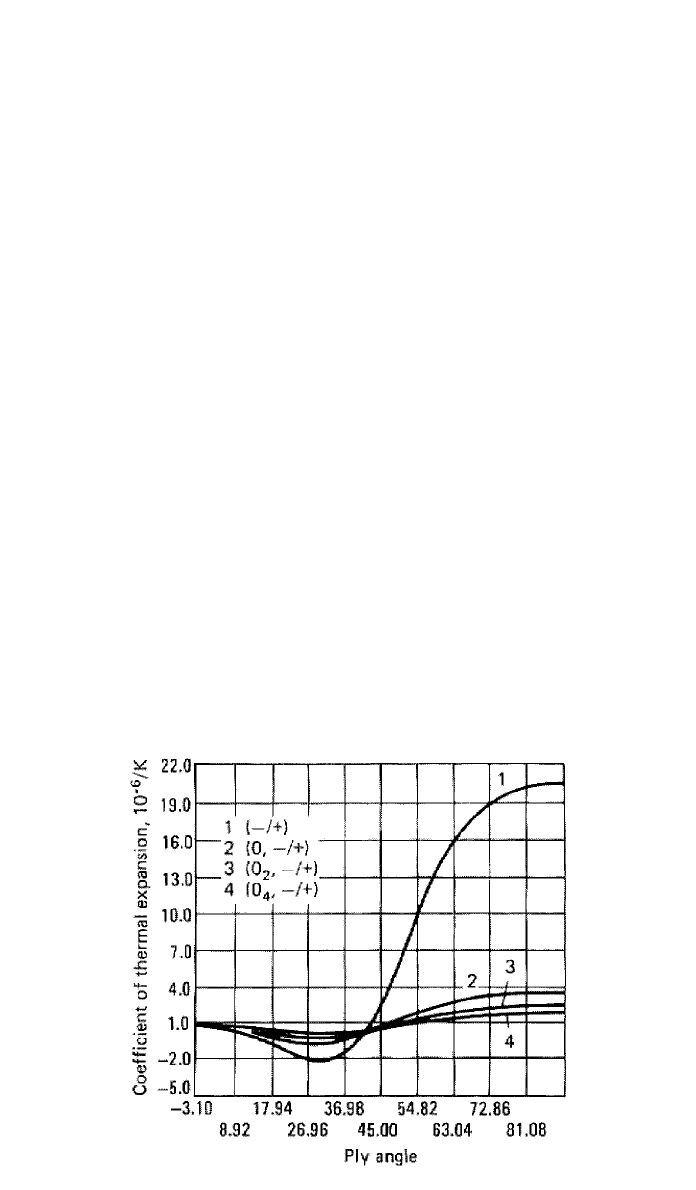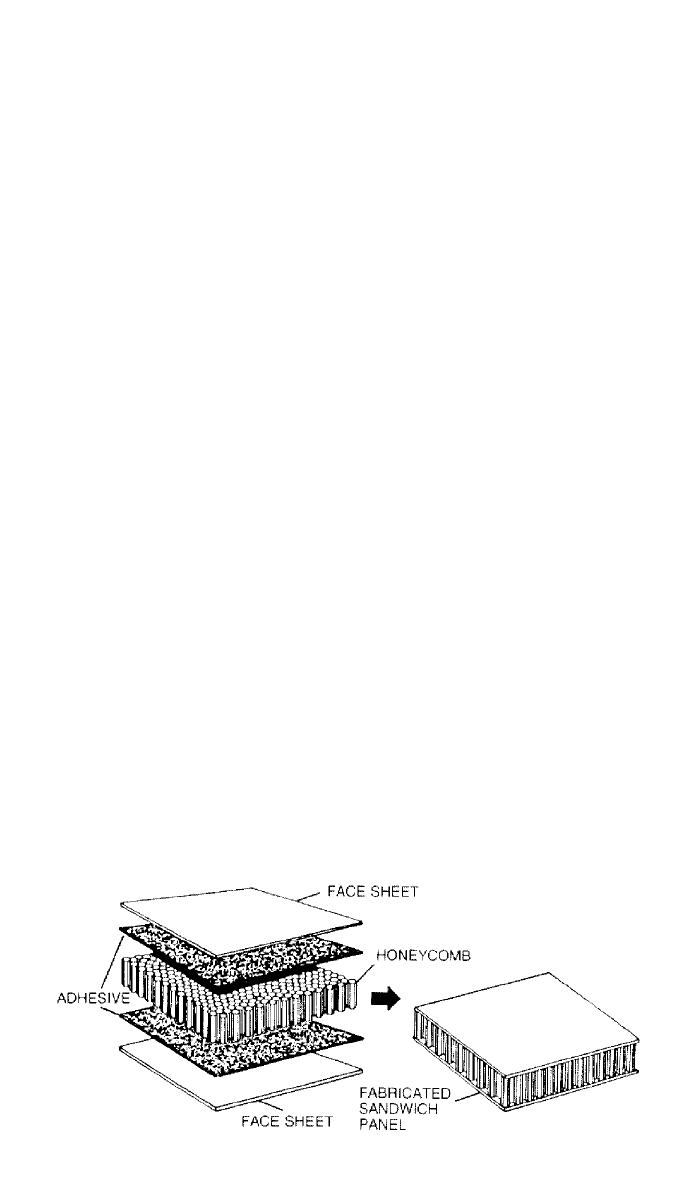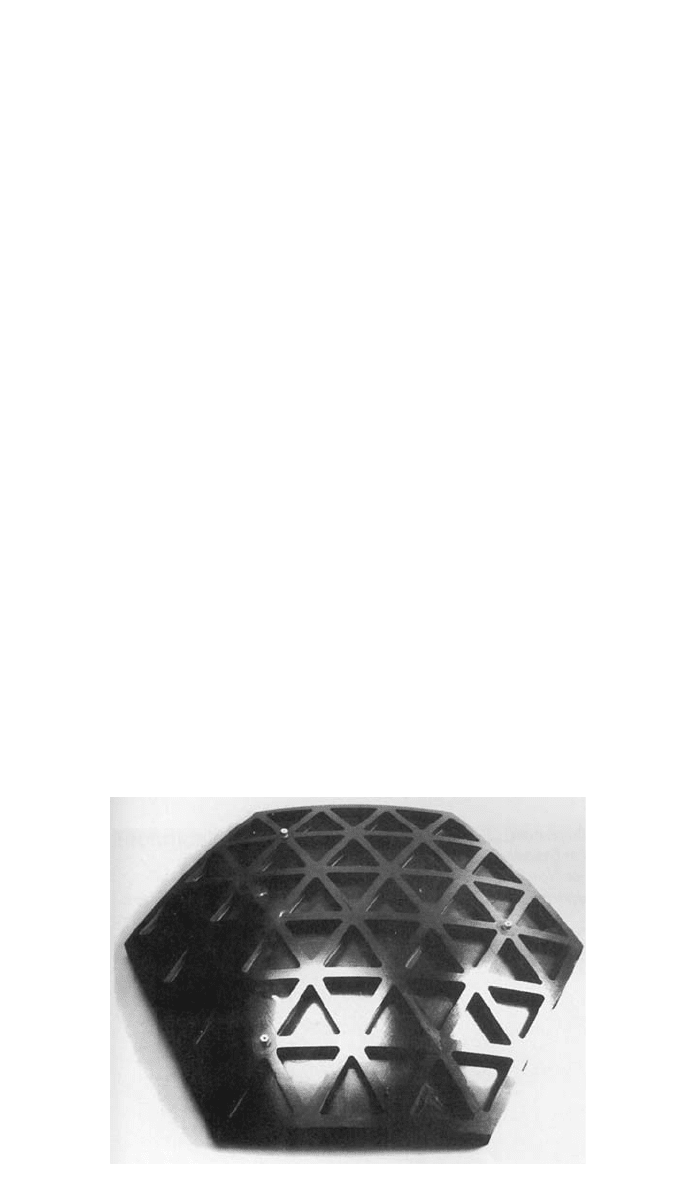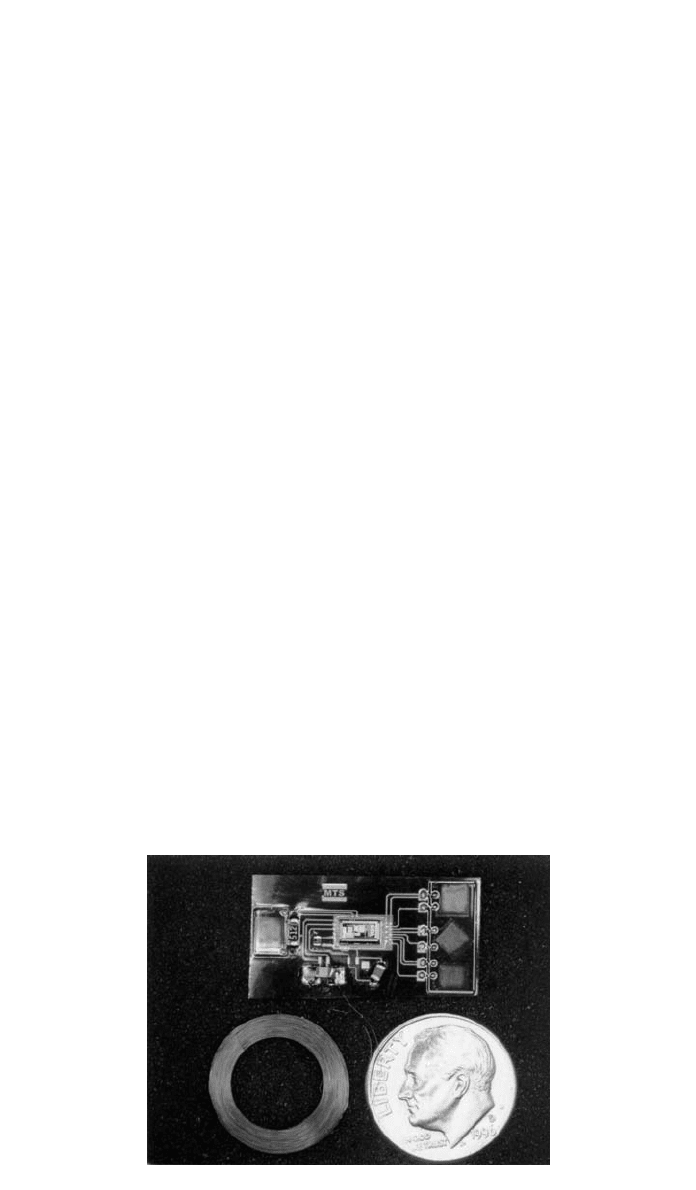Kutz M. Handbook of materials selection
Подождите немного. Документ загружается.


1138 SPACECRAFT APPLICATIONS OF ADVANCED COMPOSITE MATERIALS
Fig. 2 Longitudinal CTE for typical graphite reinforced laminates.
governed by the matrix properties and typically ranges from 20 to 35
/⬚ C.
Most applications of composites have plies oriented at various angles, producing
a net CTE in between the longitudinal and transverse values, depending on the
specific layup. Shown in Fig. 2 are values for the CTE of carbon fiber/epoxy
composite laminates for various layups. For laminates with plies at various an-
gles, fiber stiffness significantly affects the total laminate CTE since the rein-
forcement fibers are much stiffer than the polymer matrix. In general for angle
ply laminates, as fiber stiffness increases, the net laminate CTE will decrease.
This is a major reason why ultrahigh modulus fibers are often selected for pre-
cision spacecraft components.
Although the low CTE of composite laminates is an extremely valuable char-
acteristic, it can lead to new design problems, such as CTE mismatches in metal-
to-composite bonded interfaces. Careful attention must be given to thermal
strains to prevent bond failure or part deformation. Furthermore, because space-
craft often use a combination of composites and metals, the thermal expansion
of the complete structure must be analyzed to ensure that stress levels and de-
formations stay within allowable limits over the entire temperature range.
High Specific Stiffness and Strength
The most common reason for using advanced composites is mass reduction.
Unidirectional high modulus carbon fiber composites can have a longitudinal
stiffness greater than 550 GPa. This is 8.5 times greater than the specific stiffness
(stiffness/density) of most engineering metals, all of which have approximately
the same specific stiffness (see Table 2). Because unidirectional laminates have
low transverse strength and stiffness, they are not commonly used in real appli-
cations. Instead, laminates containing plies oriented at various angles are de-
signed according to the principle and secondary loads. Although the specific

2 USE OF ADVANCED FIBER-REINFORCED COMPOSITES IN SPACECRAFT 1139
0
2
4
6
8
10
12
14
16
18
[0/+45/-45/90]S
[0/+60/-60]S
[0/+45/-45]S
[0/+15/-15]S
[0]
Aluminum
Normalized Specific Stiffness
Fig. 3 Comparison of specific stiffness of various IM7/ 8552 laminates normalized
to specific stiffness of aluminum.
Table 3 Comparison of Typical Pitch Fiber Thermal Conductivities
with Aluminum
5
Fiber
Fiber Conductivity
(W/m⬚C)
Quasi-isotropic Laminate
Conductivity (W/m⬚C)
Amoco K1100 1100 322
Mitsubishi K13C 640 188
NGF YS-90A 500 151
Amoco P55 120 37
Aluminum 167 167
strength and stiffness of angle-plied laminates is less than that of unidirectional
laminates, it is still superior to metals. Shown in Fig. 3 is the specific stiffness
of IM7/8552 carbon fiber/epoxy laminates for various lay-ups. Note that since
the specific stiffness is greatest for a unidirectional lay-up, careful selection of
lay-up is key to achieving maximum mass savings.
Thermal Conductivity
Recent interest in using composites for electronics enclosures has led to higher
thermal loads being placed on composite structures. In fact, in electronics en-
closure applications for spacecraft, the thermal demands are often more impor-
tant than mechanical considerations.
4
Modern pitch-based fibers that have
thermal conductivity exceeding that of aluminum have been developed to help
meet these new demands (Table 3).
The thermal conductivity of composite laminates is similar to their mechanical
characteristics in that they are highly directional and sensitive to matrix selection

1140 SPACECRAFT APPLICATIONS OF ADVANCED COMPOSITE MATERIALS
and lay-up. For typical carbon fiber composites, the transverse and through-the-
thickness thermal conductivity is three to four orders of magnitude less than the
longitudinal thermal conductivity. Although this is often viewed as a disadvan-
tage of composites, it can be exploited to design specific thermal paths within
component modules.
5
Often a quasi-isotropic lay-up is chosen to simplify ther-
mal and mechanical analysis, but they are generally not optimal for structural
efficiency. Unfortunately, analytical prediction of the thermal conductivity prop-
erties for various laminates has proven difficult and quasi-isotropic lay-ups are
therefore selected to simplify design.
EMI Shielding and Electrical Characteristics
Electromagnetic interference (EMI) shielding is an important concern for most
space flight programs. Shielding mitigates the effect of high-energy solar radi-
ation and is used to isolate instruments from one another. Conventional EMI
shields are made of metals such as aluminum and tantalum. Many studies have
been done evaluating the use of composite materials for electronics enclosures
with the primary aim of reducing the total mass of the enclosures while main-
taining acceptable EMI shielding levels.
A typical shielding level required for spacecraft is 60 dB for a frequency
range from 0.10 to 18 GHz.
6
Although carbon fibers are inherently electrically
conductive, laminates with carbon fiber reinforcements generally do not provide
adequate EMI shielding when used alone. Several approaches to increase the
level of shielding have been studied by various groups. Common approaches to
increase the shielding effectiveness include the addition of metal foil or mesh
to the laminate, coating the finished laminate with metal, or the use of metal-
coated fibers within the composite plies.
7
Many research groups have measured the shielding effectiveness of carbon
fiber-reinforced composite laminates. The standard test method follows MIL-
STD-285 or some variation thereof. Although this standard was originally in-
tended to test the shielding effectiveness of enclosures used in EMI testing, it
is widely used as a procedure to test materials, gaskets, ventilation panels, and
apertures. The test procedure consists of placing a radiation source and a re-
ceiving antenna on opposite sides of a shielded room with a shielded barrier
between them. The material to be tested is placed over an aperture in the barrier
and the signal strength at the receiving antenna is measured. The signal loss is
then taken as the shielding effectiveness.
Test results consistently indicate that the shielding characteristics of unaug-
mented carbon fiber composites are much more similar to metals than to plastics.
By adding solid metal laminations or coatings to composite laminates, the shield-
ing effectiveness is roughly equivalent to that of solid aluminum. For multipiece
shield assemblies, experimental testing has shown that joint surface contact re-
sistance is critical for shielding effectiveness. Consequently, nickel and silver
are sometimes selected over aluminum or copper because of their superior ox-
idation resistance.
Recently, highly conductive polymers have been investigated to increase the
shielding effectiveness of composites and eliminate the need for metal coatings.

2 USE OF ADVANCED FIBER-REINFORCED COMPOSITES IN SPACECRAFT 1141
Additionally, research into using high conductivity boron interculated graphite
fibers (boron placed into the interstices of the graphite fibers) has produced
promising results.
8
Environmental Durability
The impact of space environmental effects on materials is dependent on the type
of mission, and more importantly, the orbit in which the spacecraft operates.
9
The orbital space is generally divided into three regions based on orbit altitude:
low-Earth orbit (LEO, up to 1000 km), mid-Earth orbit (MEO, 1000–35,000
km), and geosynchronous Earth orbit (GEO, 35,000 and higher). The types and
intensities of various environmental effects depend greatly on orbit altitude and
inclination. In this section the effects of various environmental factors on ad-
vanced polymer matrix composite materials will be discussed, each of which
produce distinct effects on materials. The relative importance of each of these
effects is a function of the orbital placement and must be evaluated for each
mission.
The predominant environmental factors influencing spacecraft are (1) atomic
oxygen, (2) ultraviolet radiation/solar exposure, (3) micrometeroid and debris
impact, (4) thermal cycling induced microcracking, (5) contamination, (6)
vacuum-induced outgassing, (7) spacecraft charging, and (8) environmental
synergistic effects. Of these, atomic oxygen, vacuum-induced outgassing, and
thermal cycling–induced microcracking are of unique concern to polymer matrix
composites.
The following discussion of space environmental effects on composites is
based on Silverman,
9
and the reader is referred to it for further explanation.
Atomic Oxygen Effects. Atomic oxygen erodes organic materials causing
surface recession and degradation of optical and thermal properties. Experimen-
tal results from the long-duration exposure facility (LDEF) clearly demonstrate
that atomic oxygen in LEO will erode all polymeric materials, including those
commonly used on spacecraft for thermal and electrical insulation, as paint ve-
hicles, and as composite matrix materials. The rate of erosion varies for different
materials, and in some cases is a function of exposure time. Although there is
no simple way to predict the susceptibility of certain materials to atomic oxygen
erosion, a broad database has been collected that can be used for preliminary
material screening. Of particular interest is data that confirms that polycyanate
matrices have much lower atomic oxygen reactivity than epoxy matrices.
The amount of surface recession due to erosion is directly proportional to the
atomic oxygen fluence (total integrated flux), hence the recession on a particular
surface is dependent on its location on the spacecraft and the surface attitude
relative to the flight path, spacecraft altitude, orbit inclination, and solar activity
conditions. In selecting materials for spacecraft, the designer must be aware of
atomic oxygen effects and calculate the total amount of surface erosion that will
occur. If this value is considered unacceptable, protective coatings that have low
atomic oxygen reactivity may be indicated. Materials successfully used as coat-
ing materials include extremely thin metals, silicon oxide, aluminum oxide, and
silicone room temperature vulcanization (RTV).

1142 SPACECRAFT APPLICATIONS OF ADVANCED COMPOSITE MATERIALS
Vacuum-Induced Outgassing. Polymer matrix composites tend to outgas
due to moisture desorption or evolution of volatiles within the material. The
expelled gases can be especially detrimental to optical instruments and solar
cells aboard the spacecraft. Surfaces may be obscured by condensed outgassing
products or local clouds may be formed that affect sensitive instrument readings.
Additionally, molecular contamination from outgassing can degrade the perform-
ance of thermal control surfaces, especially those that rely on passive radiative
cooling.
Outgassing of composites is characterized by three quantities based on ASTM
E595: total mass loss (TML), collected volatile condensable material (CVCM),
and water vapor regained (WVR). CVCM is a measure of the potential for
outgassed products to form surface deposits, while TML is a measure of the
potential for the formation of molecular clouds. Typical current design require-
ments are
⬍1.0% TML and ⬍0.1% CVCM, but these are expected to become
more stringent for future spacecraft. Outgassing data on specific material systems
is available in several databases. Of particular importance is the data indicating
that polycyanate and thermoplastic matrix materials characteristically produce
less outgassing products than conventional epoxy matrix materials.
Thermal Cycle–Induced Microcracking. Thermal cycling–induced micro-
cracking is due to the difference in the CTE of each individual ply parallel to
and transverse to the fiber direction. The CTE parallel to the fibers is dominated
by fiber properties and can be slightly negative. The transverse CTE is controlled
by the matrix properties and is generally about half of the value for the CTE of
the matrix alone. Consequently, internal stresses are induced due to differential
thermal expansion for any composite lay-ups that have plies oriented at different
angles. During repeated thermal cycles cracks form and grow parallel to the
fiber direction of each ply.
Microcracking of composites can cause strain hysterisis and significant
changes in the overall CTE, both of which present dimensional stability prob-
lems. However, microcracking is sometimes employed to achieve a desired CTE.
For example, the struts on the metering truss of the Hubble space telescope were
deliberately subjected to microcracking to ‘‘tune’’ them to the desired CTE.
10
New toughened epoxies and polycyanate matrix systems have greatly reduced
the severity of microcracking, but designers should remain aware of the potential
for thermal cycling–induced microcracking.
2.2 Typical Structures
Several ‘‘standard’’ structural forms are used for composite spacecraft structures:
solid laminates, sandwich laminates, strut structures, and isogrid structures. Each
form has benefits and restrictions ranging from cost to performance. This section
will discuss these forms and their applications.
Solid Laminate Construction
Solid composite laminates are the simplest of the forms used in composite struc-
tures. Several plies of a selected composite material are stacked to create a final
laminate of the desired thickness. The laminate may be treated as a continuous,
homogenous material once its properties are determined. As such, structural

2 USE OF ADVANCED FIBER-REINFORCED COMPOSITES IN SPACECRAFT 1143
Fig. 4 Sandwich structure construction. (Figure reprinted with permission of the Society of
Manufacturing Engineers, Fundamentals of Composites Manufacturing: Materials, Methods, and
Applications, Copyright, 1989.)
analysis is simplified and uncertainties are reduced. Solid laminates are best
suited to applications where the primary loading is in-plane tension or shear.
Examples include primary structural members that must withstand the axial
launch and maneuvering loads, and torsion tubes such as those used to mount
deployable solar cell arrays and antennas.
Sandwich Structures
In applications where bending stiffness and strength are critical, sandwich struc-
tures are often used because they provide high bending strength and stiffness
with low mass. Sandwich structures consist of two (or more) facesheets separated
by a low-density core (Fig. 4). This configuration provides substantially greater
bending strength and stiffness with little mass increase when compared to the
facesheets without cores. Sandwich panels with aluminum facesheets have been
used in a wide variety of aerospace applications, providing much higher bending
stiffness and strength values. The desirable properties of advanced composites
such as low coefficients of thermal expansion and directionality also apply to
sandwich structures with composite facesheets.
The most commonly used core material for space applications is aluminum
honeycomb, although other core materials such as aramid honeycomb and syn-
tactic foam are sometimes used. Typical honeycomb cores for space applications
range from 12.7 to 50.8 mm in thickness, and cell size ranges from 3.18 to 12.7
mm. Important properties that affect the selection of various types of sandwich
structures are core venting, core CTE, and the need for discrete hardpoints that
are used to attach the panel to the structure and to mount instruments to the
panel.
Venting. A very important consideration that must not be overlooked is that
the core must allow venting of gases within the core. If this is not done, high
pressure inside the core can lead to facesheet debonding or core explosion in
the space vacuum environment. The cell walls in aluminum honeycomb are
usually perforated for venting requirements.
CTE. Thermal expansion characteristics of the core must also be considered
for successful sandwich structure utilization. The in-plane coefficient of thermal
expansion (CTE) value is usually provided by the manufacturer and is assumed

1144 SPACECRAFT APPLICATIONS OF ADVANCED COMPOSITE MATERIALS
Cylindrical Cross Section
Tapered ends for
truss connections
Fig. 5 Typical composite truss member.
to be constant for all in-plane directions. However, recent experience has shown
that the CTE of aluminum honeycomb core may be different in the ribbon and
fill directions, therefore caution must be used when designing dimensionally
stable sandwich structures. Additionally, the through-the-thickness CTE is dic-
tated by the material that the honeycomb is composed of (e.g., aluminum) so
careful attention must be given to the design of end close-outs and fittings to
ensure compatibility with the sandwich structure.
Hardpoints. Because the facesheets in sandwich structures are very thin,
discrete hardpoints must be integrated into the sandwich panel to provide loca-
tions for mechanical fasteners. The hardpoints prevent fastener pullout and lo-
calized panel crushing by distributing the mechanical loads over a larger area
of the panel. These hardpoints are most often individual metal inserts bonded to
the sandwich panel. While the need for hardpoints introduces additional com-
plexity and expense, careful planning for fastener locations and fastener quan-
tities will minimize the increased fabrication cost.
Truss Structures
Truss structures composed of many individual struts are common in spacecraft
to provide stiff, large structures with low mass. Advanced composites are ideally
suited for strut applications because they carry predominantly uniaxial loads.
This allows the directional properties of fiber-reinforced composites to be ex-
ploited, producing a very efficient structure. The advantages of composite use
for mass reduction are augmented by the thermal stability inherent in composite
truss structures, which can be ensured by the specification of a wide range of
values for the coefficient of thermal expansion. A typical composite strut is
shown in Fig. 5. Aluminum or titanium end fittings are generally bonded to the
composite strut to provide attachment points.

2 USE OF ADVANCED FIBER-REINFORCED COMPOSITES IN SPACECRAFT 1145
Fig. 6 Isogrid stiffened panel (reprinted from Ref. 11).
Isogrid Structures
Isogrid construction is a new alternative method of fabricating structures that
have high bending strength and stiffness at low mass. Originally developed for
compression-loaded metallic panel designs, the isogrid concept incorporates a
unique triangular pattern of stiffener elements instead of a core structure to
achieve required stiffness.
11
Several new programs have been initiated to fabri-
cate advanced composite materials structures using the isogrid concept.
An isogrid stiffened panel is composed of three sections, each constructed
from the same base composite material. The three sections are the primary face-
sheet, the web, and the flange stiffeners, as shown in Fig. 6. Because isogrid
stiffened panels have only one complete facesheet, more radiating area is ex-
posed than in conventional sandwich panels. Consequently, isogrid stiffened
structures offer improved heat dissipation over that of honeycomb core struc-
tures. The additional radiating area is especially advantageous in the design of
solar arrays where the efficiency of the array is strongly dependent on operating
temperatures. Isogrid construction has the potential to reduce the cost of complex
structures through reduced tooling and assembly costs.
Joints
The design of composite structures must include joining considerations. Lami-
nated composites tend to have poor bearing strength and toughness when com-
pared to metals. Consequently, bonded joints are strongly preferred over the use
of discrete mechanical fasteners for joining composite materials. In contrast to
joints using discrete mechanical fasteners, bonded joints provide a distributed
load transfer that greatly reduces stress concentrations. The performance of
bonded or bolted composite material joints for a variety of loadings and ge-
ometries has been evaluated in many studies.
12
Results indicate that adhesively
bonded joints offer superior strength and reliability when compared to joints that
use mechanical fasteners such as bolts and rivets.

1146 SPACECRAFT APPLICATIONS OF ADVANCED COMPOSITE MATERIALS
2.3 Manufacturing
No discussion of the application of composite materials is complete without an
overview of the wide range of manufacturing methods available. In fact, the
manufacturing process is integral to the effective and cost-efficient use of com-
posites and must be considered throughout the entire design process. The man-
ufacturing method that is best suited to the application may be dictated by a
combination of total cost constraints, production time, production quantity, and
the physical properties required by the designer. It is impossible to provide a
concise description of all possible manufacturing methods here. A comprehen-
sive text such as Fundamentals of Composites Manufacturing provides specifics
on the various composite manufacturing methods/processes.
13
Some of the
unique aspects of composite structure manufacturing will be discussed here, with
a primary focus on cost reduction.
Reduction in component cost and complexity are always welcome attributes
for spacecraft. Because composites are built up and formed by material addition
instead of material removal, consolidation of many individual components into
one entity can be achieved. This consolidation reduces the part count (and there-
fore cost) and results in more compact and efficient structures. Reduction of the
size and mass of entire systems has become more important as spacecraft be-
come smaller. Part consolidation is a key technology to achieving this goal.
New communication and observation systems that use constellations of mul-
tiple small satellites are being designed. Spacecraft design for these programs
represents a departure from the traditional design philosophy because many sim-
ilar or identical satellites must be produced in a costly manner. The use of
advanced composite structures instead of metals may potentially reduce recur-
ring manufacturing costs significantly. Most metal parts for spacecraft are pro-
duced by the removal of material from a larger entity to achieve the finished
form. This machining constitutes the majority of the cost in the production of
metal parts. The use of composite components on the other hand can drastically
reduce recurring machining cost and material waste because a single reusable
mold can be used to produce many near-net shape parts.
An assortment of cost reducing automated or computer-assisted processes are
available that may minimize labor expenses. Commonly used manufacturing
processes include filament winding, automated tow placement, automated ply
cutting, laser-projected lay-up templates (guides), pultrusion, matched die mold-
ing, and resin transfer molding. Not all processes work equally well for every
structure; instead one or two processes are usually far superior for a particular
structural configuration.
Multifunctional Structures
Mechanical parts, sensors, wiring, and electronic components can be combined
in single composite structures to form integrated, or multifunctional, structures.
Because composite materials are manufactured or built up from many thin in-
dividual plies, individual component elements may be embedded within the lay-
ers as they are applied (referred to as packaging). The resulting multicomponent
integration is a necessary design element in the success of future small satellite
missions. The embedding of passive or active electronic components provides

2 USE OF ADVANCED FIBER-REINFORCED COMPOSITES IN SPACECRAFT 1147
Fig. 7 ARRQEM sensor package.
new opportunities and venues for integrated component diagnostics, sensing, and
structural health monitoring.
Multifunctional structures are broadly defined as structures that support
additional tasks that may be unrelated to basic mechanical load carrying.
14
Examples of functions included in this definition are damping enhancement
elements, passive electronics and circuits, sensors, actuators, and active elec-
tronics. Multifunctional structures may include different levels of complexity
that range from simple passive thermal management or electromagnetic wave-
guides to advanced fully integrated adaptive structures containing sensors,
actuators, and active electronics. Research groups have commonly adapted a
stepping stone approach toward the achievement of the ultimate goal of highly
integrated structures with minimum mass and volume. The vast body of work
in this area will not be covered here, but a brief overview of some of the more
mature technologies is provided below.
Embedded-Sensor Technology. Substantial work has been done to develop
techniques for embedding sensors in composite structures and in testing their
response. Much of this research has been focused on the embedding of various
types of strain sensors in composite structures to create integral, real-time dis-
tributed sensing of local strains. The data provided by these sensors is useful
for the determination of the status of deployable structures, in the design of the
shape or form of spacecraft components, in the measurement of vibration levels,
and for damage detection.
Starting in 1994, a program of research began into remotely queried embed-
ded microsensors (RQEM) sponsored by the Naval Research Laboratory. RQEM
developed a working prototype of the sensor and solved many of the difficult
research issues. In 1997 a follow-up program, Applied Research in Remotely-
Queried Embedded Microsensors (ARRQEM), refined the system concept (Fig.
7) and solved many of the difficult engineering issues.
The primary target materials for the installation of remotely queried sensors
were the various aerospace composites, including glass and carbon-fiber rein-
forced thermoset and thermoplastic resins. It is undesirable to use ‘‘wired’’ sen-
